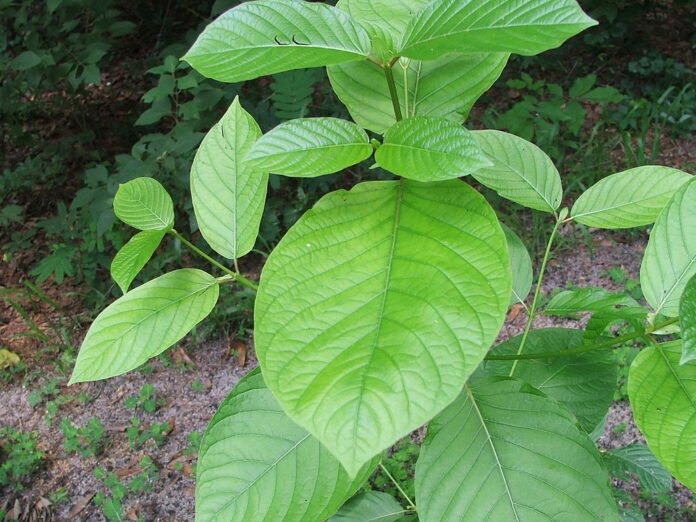Image- Uomo vitruviano – Eigenes Werk, CC BY-SA 3.0, https://commons.wikimedia.org/w/index.php?curid=12196426
Mitragyna speciose, or commonly known as kratom, is a plant with its origins in Southeast Asia. However, with its introduction and cultivation in many parts of the world, including Europe and America, it’s slowly gaining popularity worldwide.
Kratom belongs to the same taxonomic family as coffee and gardenias. It is a stimulant that many Asian countries, such as Thailand, have been using as a herbal remedy for centuries. With stimulating and opioid effects, the plant has been utilized both for medicinal and recreational purposes.
While the stimulating effects are well-known, we know little about the medicinal properties of the plant. Consequently, it has been used mainly as a recreational drug in the West, but emerging scientific data is starting to change this. Many studies have shown that kratom has chemical components that have medicinal effects and is available as a therapeutic supplement in many countries.
You can easily buy kratom online in the form of compressed tablets, capsules, or as loose chopped leaves that the buyer can add to food such as tea. However, many controversies surround kratom, and you may be confused by the information available out there.
So, let’s look at some facts about kratom.
1. Kratom is not a Synthetic Drug
While drug enforcement agencies compare kratom to synthetic heroin, it is purely organic.
Kratom is a natural product, and its processing does not involve the use of any chemicals or additives. It is purely a plant-based product and used in its natural form. Once picked and dried, the vendors pack the leaves in capsules, sachets, or gel caps. The product comes only from the leaves of the plant, scientifically known as Mitragyna speciose.
Kratom grows naturally in most of Southeast Asia. The plant has been used in most Asian countries for its medicinal properties. The leaves are bitter and contain compounds that have opioid-like effects. Users take the leaves for their pain relief, aphrodisiac, and mood-altering effects and can chew, smoke, or brew it into tea and other foods.
Kratom is not “Bath Salts” or “spice” as some sources may term it.
These drugs are synthetic and contain active ingredients that are banned by the US Drug Enforcement Agency.
2. Kratom Is not Dangerous if used Appropriately
Kratom is not dangerous when used appropriately, but abuse or overdose can have adverse side effects.
A study by the US Center for Disease Control (CDC) found that kratom was detected in the system of several individuals who had died of a drug overdose. The study, which looked at 27,000 cases of unintentional drug overdoses, found that 152 individuals had kratom in their system. However, it is difficult to attribute these deaths solely to kratom. The postmortem toxicology reports also found the presence of other drugs, including cocaine, heroin, prescription opioids, fentanyl, and benzodiazepines in the systems of the subjects.
While some reports have linked kratom to some deaths in Europe and America, there is no data on kratom-related deaths in Southeast Asia.
One study found the active ingredient mitragynine in the blood of examined bodies but ruled out kratom as the cause of casualty due to poly-drug exposures. The authors concluded that deaths related to kratom could be due to herb-drug interactions with other drugs that affect the central nervous system.
Hence, adulterated or contaminated kratom could cause death. While pure kratom is safe, it does not come without side effects. Known acute side effects include dry mouth, sweating, itching, nausea, and increased urination. Prolonged use can also cause hallucination, delusion, anorexia, weight loss, and insomnia.
3. Is Kratom Addictive?
In its place of origin, the natives commonly use kratom to manage opioid withdrawal symptoms because it has less potential for addiction. Nonetheless, when overused, it can lead to dependency. Animal studies have confirmed that mitragynine functions as an addictive drug.
Studies in Malaysia and Thailand, have found that addiction is mainly prevalent among the educated population. While the less learned can use it for opium withdrawal without becoming addicted. Researchers have attributed this to the understanding among the well-educated that kratom is natural, and therefore, safe. Regardless, it’s better to be careful while using kratom as it presents a potential for addiction.
4. Kratom is legal
Kratom is a legal product in most countries, including the United States. You can easily buy kratom online. Most local smoke shops, gas stations, and health stores also sell kratom.
In 2016, the DEA tabled concerns regarding the purity levels and quantity of mitragynine and 7-hydroxymitragynine, which are the active ingredients.
Kratom plant has several varieties, each with its potency levels. Due to these uncertainties and inconsistencies in the active ingredients, they pose health risks to users because they may not know how much of the drug they are taking.
Hence, the DEA is considering scheduling kratom. In Thailand, Malaysia, and Myanmar, kratom is prohibited because of its potential for abuse. Also, it is not scientifically recognized as a medicinal plant in these countries.
Conclusion
Kratom has many beneficial properties, but it also comes with many controversies. This is because it is a new plant in the West, and there is little extensive research on the plant.
As research continues, the plant will gain widespread use for its medicinal properties. The plant also has various strains, each with different levels of potency.
This results in different outcomes among users, depending on the variety they have used. This difference has also led to further confusion about the effects and adverse reactions of kratom.


























